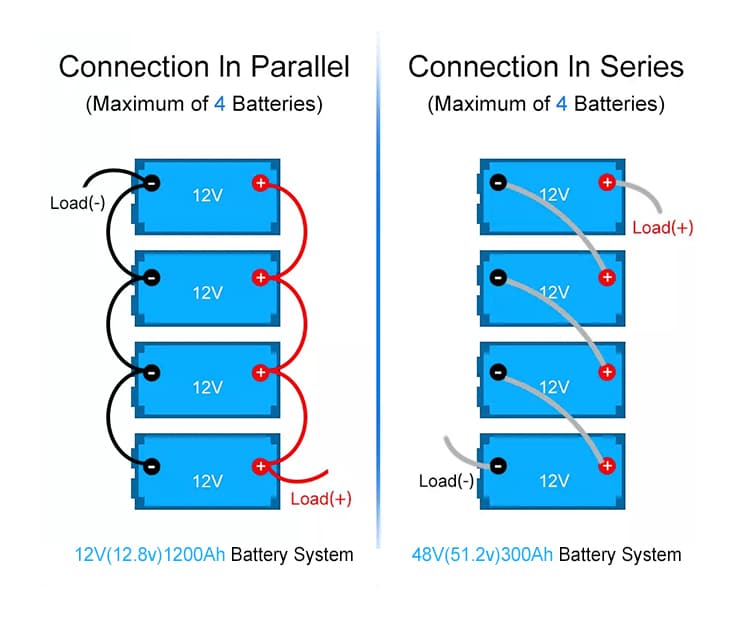With the development of global diversification, our lives are constantly changing, including the various electronic products we use. Batteries usually appear in our lives in series or parallel, so do you know the difference between series batteries and parallel batteries?
Battery connection classification: battery series and parallel
If your application requires more voltage and current than a single battery can provide, you may choose to set up a multi-battery system.
We generally set up a multi-battery system by connecting batteries in series or parallel.
Connecting multiple batteries in series in a lithium battery pack can obtain a higher operating voltage.
And connect the batteries in parallel, and you can get higher capacity and larger current. If you combine the two methods of series and parallel, you can get battery packs that meet high voltage and high capacity standards. For example, for a 36V 10AH electric vehicle battery, 50pcs 2000MAH 3.6V lithium-ion batteries are connected in parallel so that the capacity can reach 10AH; then, ten groups of parallel batteries are connected in series to reach above 36V.
Connecting batteries in series and parallel increase the total available energy (Wh); they do this in different ways and provide different results. Therefore, the connection method should be chosen according to the target customers’ needs.

What’s The Difference Between Series and Parallel Batteries?
Parallel connection: Several batteries, positive and positive, negative and negative, are connected side by side, the voltage remains unchanged, the capacity increases, and the corresponding current also increases.
Series connection: Several batteries are connected in series, that is, positive and negative; the negative of the first section is connected to the positive of the second section, and so on. As the voltage increases, the capacity remains the same.
The main difference between connecting batteries in series versus parallel is the effect on output voltage and battery system capacity. Batteries connected in series will add their voltages together, and batteries connected in parallel will add their capacities. But the total available energy (in watt-hours) is the same in both configurations.
For example, two 12v 100 Ah lithium batteries connected in series will get a lithium battery with an output capacity of 24V 100 Ah. Connecting two 12v 100 Ah lithium batteries in parallel provides 12 v voltage and 200 Ah capacity. The total available energy for both systems is 2400 Wh (Wh = Volts x Amp hours).
In addition, both series and parallel configurations batteries should have the same rated voltage and rated capacity. Mixing and matching voltage and capacity may result in battery damage.
Wiring Batteries in Series
To connect multiple batteries in series, connect each battery’s positive terminal to the next battery’s negative terminal. Then, measure the total output voltage of the system between the negative terminal of the first battery in series and the positive terminal of the last battery.
When the application requires a higher voltage, we want to increase the voltage, and the method of connecting batteries in series is the most suitable. And tandem batteries are easy to manufacture and maintain.
Portable devices that require high power are generally powered by a battery pack of two or more batteries connected in series. If a high voltage battery is used, the conductors and switches can be tiny.
Mid-priced industrial power tools generally run on batteries with 12V to 19.2V, while high-end power tools use batteries with 24V to 36V for more power. The auto industry eventually increased the starter battery voltage from 12V (actually 14V) to 36V or even 42V. These battery packs consist of 18 lead-acid batteries connected in series.
In early hybrid cars, the battery pack used to supply power had a voltage of 148V. The battery pack used in newer models has a voltage of up to 450V to 500V, and most of them are nickel-based chemical batteries. A nickel metal hydride battery pack with a voltage of 480V is formed by connecting 400 nickel metal hydride batteries in series. Some hybrid cars have also been tested with lead-acid batteries.
Advantages
When batteries are connected in series, the voltages add while the amperage remains the same. Therefore, we can connect the batteries with thinner wires, the current consumption is lower, and the voltage of the whole system is lower than that of a parallel connection. Cells in series are easy to build and can quickly detect if one of the cells is dead or malfunctioning. Series batteries are more stable.
Disadvantages
We can obtain a high-voltage battery pack through a series connection, but the high-voltage battery pack will bring another problem; that is, it is possible to encounter the failure of a particular battery in the battery pack. It’s like a chain, the more batteries you have in a series, the higher the chances of this happening. Whenever there is a problem with a battery, its voltage will drop. In the end, a “disconnected” battery may interrupt current delivery.
Replacing a “bad” battery is also not easy, as old and new batteries are mismatched. Generally speaking, new batteries have a much higher capacity than older batteries. As the working voltage drops, it reaches the critical point of the end of discharge faster than normal battery packs, and at the same time, its service time is also shortened sharply.
Once the device cuts off the power supply due to low voltage, the remaining single cells that are still intact cannot deliver the stored power. At this time, the bad battery still presents a large internal resistance. If there is still a load at this time, it will cause the output voltage of the entire battery chain to drop significantly.
A bad battery acts like a plug in a water pipe in a string of batteries in series, creating a huge resistance that prevents current from flowing through. Other cells can also be shorted, dropping the voltage at the terminals, or disconnecting the battery pack and cutting off the current flow. The performance of the worst cell in the pack determines the performance of a battery pack.
Wiring Batteries in Parallel
Two or more batteries can be connected in parallel to get more power. In addition to connecting batteries in parallel, another way is to use larger batteries. Due to the limited available batteries, this method is unsuitable for all situations. In addition, large-sized batteries are not suitable for the form factors required for special-purpose batteries. Most battery chemistries can be used in parallel, with lithium-ion batteries being the best. For example, a battery pack consisting of 5 cells connected in parallel keeps the voltage at 3.6V, while the current and run time is increased by 5 times.
To connect multiple batteries in parallel, connect all positive and negative terminals together. Since all positive and negative terminals are connected, you can measure the system output voltage at any two positive and negative battery terminals.
Advantages
Connecting batteries in parallel can increase run time while keeping the voltage constant. For example, connecting two batteries in parallel will double the run time. When batteries are connected in parallel, the other batteries in the system will continue to provide power even if one fails.
Disadvantages
A high impedance or “open” battery has less effect in a parallel battery circuit than a battery series connection. However, paralleling battery packs reduces load capacity and shortens run time. It’s like an engine with only three cylinders activated; the damage caused by a short circuit would be much more significant. Because a battery that fails during a short circuit can quickly drain the charge in the other batteries, damaging the life of the entire battery pack. Also, parallel batteries take longer to charge the system.
How Many Batteries Can You Wire In Series?
The number of cells in a series usually depends on the cell and manufacturer. The more connected in series, the higher the requirement for the consistency of the battery. For example, KHLiTech allows up to 4 lithium batteries to be connected in series. Therefore, before deciding to connect batteries in series, you need to check with the battery manufacturer as to the maximum number of batteries that can be connected in series to ensure that no safety issues will occur.
How Many Batteries Can You Wire In Parallel?
The more batteries connected in parallel, the more capacity is available and the longer the run time, but the longer it takes for the system to recharge. Likewise, high currents mean a greater need to protect against accidental short circuits, where high currents can spell catastrophe. KHLiTech allows up to 15 lithium batteries to be connected in parallel.
FAQ
Batteries in Series Vs. Parallel: Which Is For You?
The series connection of batteries is suitable for occasions where the current remains constant, but the voltage needs to be increased. Batteries connected in parallel are ideal for occasions requiring higher currents. Whether connected battery in series or parallel, the output power of the battery pack increases.
The choice of connecting batteries in series or parallel depends on where you want to use them.
Can I parallel two different batteries?
Batteries connected in parallel must have the same voltage, such as a 12V battery cannot be connected to a 24V battery in parallel. In addition, it is best to use batteries of the same capacity for parallel connection.
Custom Battery Solution – Reliable Lithium Battery Manufacturer
We can get the proper voltage and current by connecting batteries. Whether it is through series or parallel, it has certain challenges. So you can find a professional battery manufacturer to provide customized battery solutions to meet your needs.
KHLiTech has been focusing on the lithium battery industry for 15 years and has rich experience customizing lithium batteries. We can customize lithium battery solutions for different fields, such as RVs, scooters, golf carts, ships, solar systems, etc. In addition, you can specify to add some unique features, such as Bluetooth control, high-rate battery, and self-heating function. KHLiTech lithium battery always adheres to the principle of quality first. Contact us for more detailed information.

Conclusion
Connecting batteries in series increase voltage, and connecting batteries in parallel increases current. Before you decide which connection method to use, please carefully weigh your needs, or seek the help of a professional engineer.





1 thought on “Parallel Vs. Series Batteries”
The eloquence and depth of your writing are truly remarkable. Each word is like a brushstroke on a canvas, creating a masterpiece of thought and expression. Your article is a testament to your talent as a writer and a source of inspiration for all who have the pleasure of experiencing it.